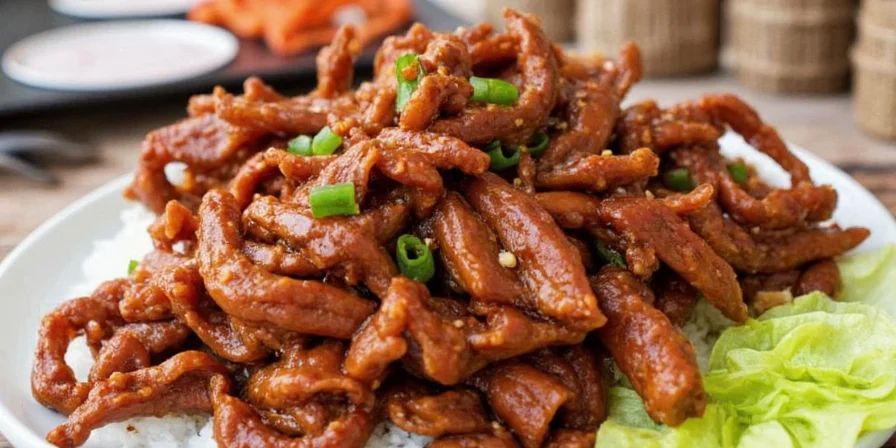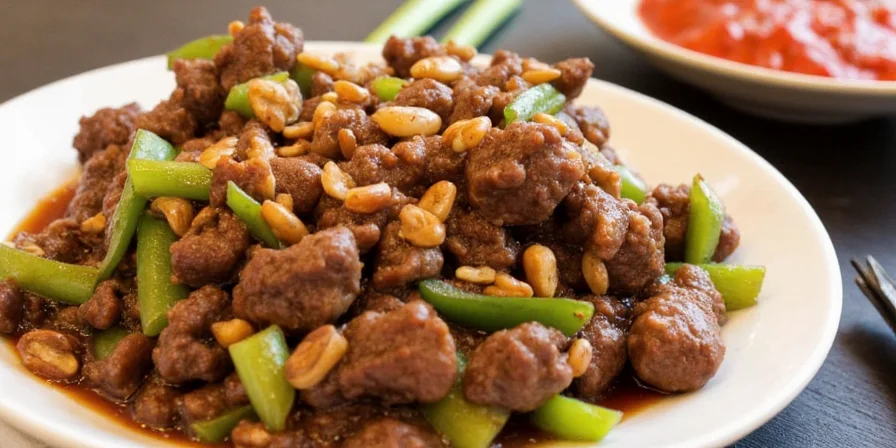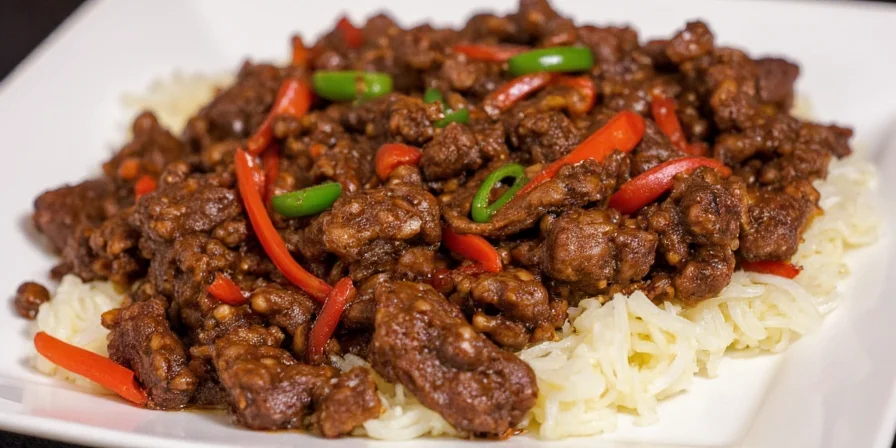Spice & Sizzle: The 7 Secrets Behind the Perfect Szechuan Beef Recipe (With a Dash of Humor)
Welcome to the fiery world of Szechuan Beef Chinese cuisine — where heat meets harmony, and flavor dances on your tongue like it’s at a spice-themed rave. Whether you’re a seasoned chef or just someone who’s mastered boiling water (and that’s okay!), this guide will walk you through everything you need to know about crafting an authentic Szechuan beef dish without setting your kitchen—or taste buds—on fire.
Table of Contents
- A Brief History of Szechuan Beef
- The Spice Lineup: Key Ingredients You Can’t Skip
- Cooking Techniques for Maximum Flavor
- Common Mistakes (And How to Avoid Them)
- Pro Tips from Spicy Pros
- Global Twists: Regional Variations Worth Trying
- Pairing Perfection: What Goes with Szechuan Beef?
- Conclusion
🌶️ A Brief History of Szechuan Beef: When Spice Met Region
The roots of Szechuan beef stretch deep into China's southwestern province of Sichuan, where the humid climate and bold flavors have long gone hand in hand. Known as the “Land of Abundance,” Sichuan is famous not only for its pandas but also for its punchy dishes that use a unique blend of spices, especially the infamous Sichuan peppercorn, which doesn’t technically burn—it tingles!
While many people confuse Szechuan beef with other spicy stir-fries like Hunan beef, the real difference lies in the numbing quality of the former. The latter? Just plain hot. Think of it as the difference between falling in love (Szechuan) vs. being slapped by your ex (Hunan). 💔🔥

🧂 The Spice Lineup: Key Ingredients You Can’t Skip
Szechuan beef isn’t just about chili; it’s a full orchestra of aromatics, textures, and flavors. Here’s what makes the ensemble sing:
- Sichuan Peppercorns: The MVP. Not a true pepper, these berries create a numbing effect that makes your mouth tingle like you’ve been kissed by a ghost chili.
- Dried Red Chilies: These bring the heat and color. Crushed or whole, they’re essential for that signature red glaze.
- Garlic & Ginger: The dynamic duo. No flavor without them.
- Kombu or Soy Sauce: For umami depth.
- Shaoxing Wine: Adds richness and complexity.
- Cooking Oil (Peanut or Vegetable): Helps infuse the spices and coat the meat properly.
- Flour-coated Beef: Gives it that crispy texture when stir-fried.
| Ingredient | Purpose | Alternative |
|---|---|---|
| Sichuan Peppercorns | Numbing spice sensation | Black Pepper + Lemon Zest (not ideal, but works!) |
| Dried Red Chilies | Heat & color | Fresh Thai chilies or chili flakes |
| Shaoxing Wine | Flavor depth | Dry sherry or rice wine |
🔥 Cooking Techniques for Maximum Flavor
How you cook determines how your Szechuan beef tastes. It’s not just about throwing everything into a pan. Here are some key techniques:
- Braising vs Stir-Frying: For restaurant-style crispiness, stir-frying is king. If you're looking for softer textures and deeper flavors, braising can be a great alternative.
- Dry-Frying Technique: Toasting spices before adding oil maximizes their aroma. This step shouldn’t be skipped unless you want your dish to sound more like elevator music than a symphony.
- Coating the Beef: Using cornstarch or flour helps seal in juices and gives a nice crunch when seared.
- Oil Temperature Control: Keep the wok hot! Too low and your beef steams instead of sears. Aim for around 350°F (175°C).

🚨 Common Mistakes (And How to Avoid Them)
We’ve all been there—trying to recreate a delicious memory from a favorite Chinese restaurant only to end up with something that looks like regret in a bowl. Let’s fix that:
- Overloading the Pan: Don’t overcrowd. Cook in batches so the beef browns instead of steams.
- Skipping the Marinade: Marination adds layers of flavor. At least 30 minutes of resting time is ideal.
- Burning the Spices: Sichuan peppercorns and dried chilies can go from fragrant to bitter fast. Keep the flame medium when blooming them in oil.
- Not Balancing the Flavors: Spicy ≠ salty. Make sure you adjust soy sauce and sugar levels to avoid one-dimensional flavor.
💡 Pro Tips from Spicy Pros
Want to take your Szechuan beef game to the next level? Here are some insider secrets from chefs who make spicy dreams come true every day:
- Add a Pinch of Sugar: Balances the salt and heat, creating a more rounded flavor profile.
- Toast Your Peppercorns First: Dry toast them in a pan before grinding for more intense numbing power.
- Double Chili Power: Use both crushed and whole chilies for varying heat intensity and visual appeal.
- Garnish Like a Boss: Fresh scallions or sesame seeds add crunch and contrast.
- Let it Rest: Allow the dish to sit for 5–10 minutes after cooking so the flavors meld together.

🌍 Global Twists: Regional Variations Worth Trying
While the original recipe comes from Sichuan, variations have popped up worldwide. Here’s a look at how different cultures put their spin on this classic:
| Region | Key Twist | Description |
|---|---|---|
| Hong Kong | More sweetness | Mirin or oyster sauce added for extra sheen and sweet notes. |
| Malaysia | Lemongrass kick | Fragrant lemongrass added for citrusy brightness. |
| California | Vegetarian version | Tofu or mushroom-based substitutes used for plant-forward twist. |
| Texas | BBQ Smoke | Smoked paprika or mesquite used for a Tex-Mex flair. |
🍽️ Pairing Perfection: What Goes with Szechuan Beef?
Szechuan beef is bold, so pair it with something that complements without overpowering:
- Rice: Jasmine or basmati rice absorbs the flavorful sauce and cools things down.
- Steamed Buns: Great for wrapping leftovers into spicy handheld treats the next day.
- Cucumber Salad: Offers a refreshing contrast with vinegar and sesame dressing.
- Iced Green Tea: Soothes the palate better than milk or water.
- Cold Beer: Preferably a light lager or wheat beer to cut through the spice.
🔥 Conclusion: Mastering the Magic of Szechuan Beef
So, there you have it—a complete breakdown of the beloved Szechuan beef, from history to heat. Whether you're trying to impress guests, satisfy your cravings, or just flex your culinary muscles, this dish is a perfect blend of technique, tradition, and a touch of drama.
Remember, the best Szechuan beef is not necessarily the spiciest—but the most balanced. So don't be afraid to play with ratios, test new ingredients, or even try a vegan version if you're feeling adventurous. And above all, enjoy the process. Because nothing says ‘I survived the spice gauntlet’ quite like finishing a plate of homemade Szechuan beef and still being able to feel your face. 😄
Stay spicy, stay curious, and keep exploring Global Spice Traditions—one bite at a time.










 浙公网安备
33010002000092号
浙公网安备
33010002000092号 浙B2-20120091-4
浙B2-20120091-4